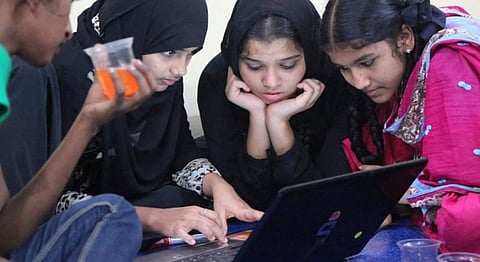
- HOMEGROWN WORLD
- #HGCREATORS
- #HGEXPLORE
- #HGVOICES
- #HGSHOP
- CAREERS
- ABOUT US
- CONTACT US

One of the largest slums of Asia with estimated population of close to one million people, the Dharavi slum has already had plenty of introductions in pop-culture and news beats across the world. Sprawled across 500 acres of land in a congested city that’s tight on space, it’s become famed to be a microcosmic world with its own local art, crafts, musicians and dancers; from popular, and slightly lengthy, slum tours to a thriving leather industry, Dharavi has proven itself to be a powerhouse of untapped human resources, skills and knowledge, and home to some very unique creations and innovations. Most recently, a group of teenage girls have developed apps to help overcome issues relevant to their community. As reported by Mashable, the girls, aged eight to sixteen, are part of an innovation project called Dharavi Diary in Naya Nagar which was started by filmmaker Nawneet Ranjan in 2014. Under his guidance, the girls identified certain key problems, such as water shortages, sexual harassment and lack of educational facilities, and using the MIT App Inventor, an open-source web application which lets you design software applications, created apps around the issues at hand.
It was in 2012, when Ranjan come to Dharavi to film a documentary titled Dharavi Diary that he began interacting with the residents. Wanting to get more involved he later moved from San Francisco to Mumbai with the aim of using stories and technology to empower the girls in mind. “These kids didn’t have dreams and aspirations because they live in such difficult circumstances, with many facing abuse and domestic violence,” says Ranjan. “I tried to get them to understand how technology can be used to make a paradigm shift and challenge the status quo.”
Using the MIT App Inventor along with online tutorials, instructional videos and Powerpoint presentations he taught the girls the basics of coding. “A lot of girls in the neighbourhood don’t get the chance to use computers and laptops,” he tells Mashable. “I showed them how technology can be used to solve problems and improve their job opportunities. I told them that these were things that they could learn on their own.”
The experience has been incredibly rewarding and life-changing for a lot of the girls involved. Before Ranjan’s programme, 14-year-old Ansuja Madhiwal felt depressed and hopeless after the passing of her father in a road accident leaving her to be raised by her mother. Now, after gaining strength and self confidence, she wants to become a computer engineer, even building the Women Fight Back app for Android, which has features like SMS alerts, location mapping, distress alarm and emergency calls to your selected contacts. Another ingenious creation is the Padhai app which has language lessons and other tutorials for those girls who are unable to go to school. Water scarcity was identified by the girls as a major problem and they provided a solution with the Paani app, which creates an online queue of sorts for each house and sends alerts to people to let them know when it’s their turn to fill water, providing equal access for all to the water supply.
Developing apps is only one aspect of this incredible programme. The project teaches children Science, Mathematics and English through “experiential activities.” They learn English by taking pictures of nouns and pronouns, for example, even picking up trash and remodelling it into something useful; all activities encouraging the kids to think critically, creatively and out of the box. In a span of two years, the project has grown from 15 children to now having over 200, even including a few boys.
The future looked bright for these girls, but unfortunately they faced a huge setback on January 4 when a fire broke out in Naya Nagar, destroying the houses of over 50 families along with the technological resources used by the girls. Ranjan hopes to raise more money for the programme through a crowd-funding campaign to help get computers, laptops, and basic amenities like food and clothing for the children as they slowly rebuild their lives.
Click here to know more about the Dharavi Diary project and contribute to the campaign by visiting the project’s campaign page.
Feature image courtesy of Mashable
